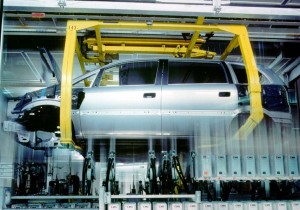General Motors has taken a critical step forward in its bid to salvage its money-losing European operations, shuttering an unneeded plant in Bochum, Germany.
The closure of the factory, which once employed as many as 22,000 workers, is central to a bid to reverse 15 years of losses by the Adam Opel subsidiary. At the same time, GM plans to invest 4 billion Euros, or nearly $5 billion into its European business to expand its product portfolio and improve the competitiveness of its remaining factories.
The maker now says it expects to achieve a break-even at Opel by mid-decade. But that goal has been delayed so long that industry analysts are playing wait-and-see before declaring GM’s latest turnaround strategy a success.
The closure of the 52-year-old Bochum plant is significant for a variety of reasons. It is, notably, the first German auto assembly line to be shuttered since the end of World War II. And its closure comes as Europe’s auto industry begins to show just the first faint glimmers of revival after one of the worst economic downturns since the end of the war.
Going into the crisis, industry analysts had estimated that the Continent had as many as a dozen more assembly plants than needed. But strict European job rules have made it difficult – and extremely costly – to shutter redundant factories. Only a handful of makers, including Ford and Fiat Chrysler and now GM, have been able to win approval for plant closures.
It was expected that Opel would spend at least several $100 million as part of an agreement with its German union, to complete the shutdown.
(GM investing more than $1 billion in plants in Europe, North America. For more, Click Here.)
The maker had originally planned to keep Bochum open for another year or more, but the last Opel Zafira van rolled down the line Friday. It is unclear what will happen with the majority of workers at the factory, though about 300 will continue to find work at a parts depot that will use a small portion of the old assembly plant.
The closure of the Bochum plant alone does not guarantee Opel’s future success, the company has acknowledged. That will require an array of new products and a turnaround in the brand’s image.
(Click Here for details about GM’s recall of 2,300 midsize trucks.)
Once seen as one of the better European marque’s Opel’s reputation was sullied by a variety of mistakes over the last several decades, especially when it came to product plans.
The situation became severe enough that following its emergence from bankruptcy in mid-2009, GM considered selling off a majority stake in the European subsidiary. It negotiated a deal with a consortium linking Russian investors and the Canadian mega-supplier Magna International. The deal was scrapped, however, just weeks before it was supposed to be completed.
(To see why Toyota is debuting its new Tacoma at the Detroit Auto Show, Click Here.)
GM then set out to develop a new turnaround that would keep Opel in its family. Closing Bochum became one key element. But the maker has also launched an assortment of new products. Some, like the little Opel Adam, have been generating solid sales – giving GM hope that it can finally achieve a breakeven and start putting its balance sheet back in the black before the end of the decade.


They can only cut and slash so much … eventually they will have to innovate and win customers back. Whether they now have the capacity to do this after all the bloodletting they’ve done remains to be seen.